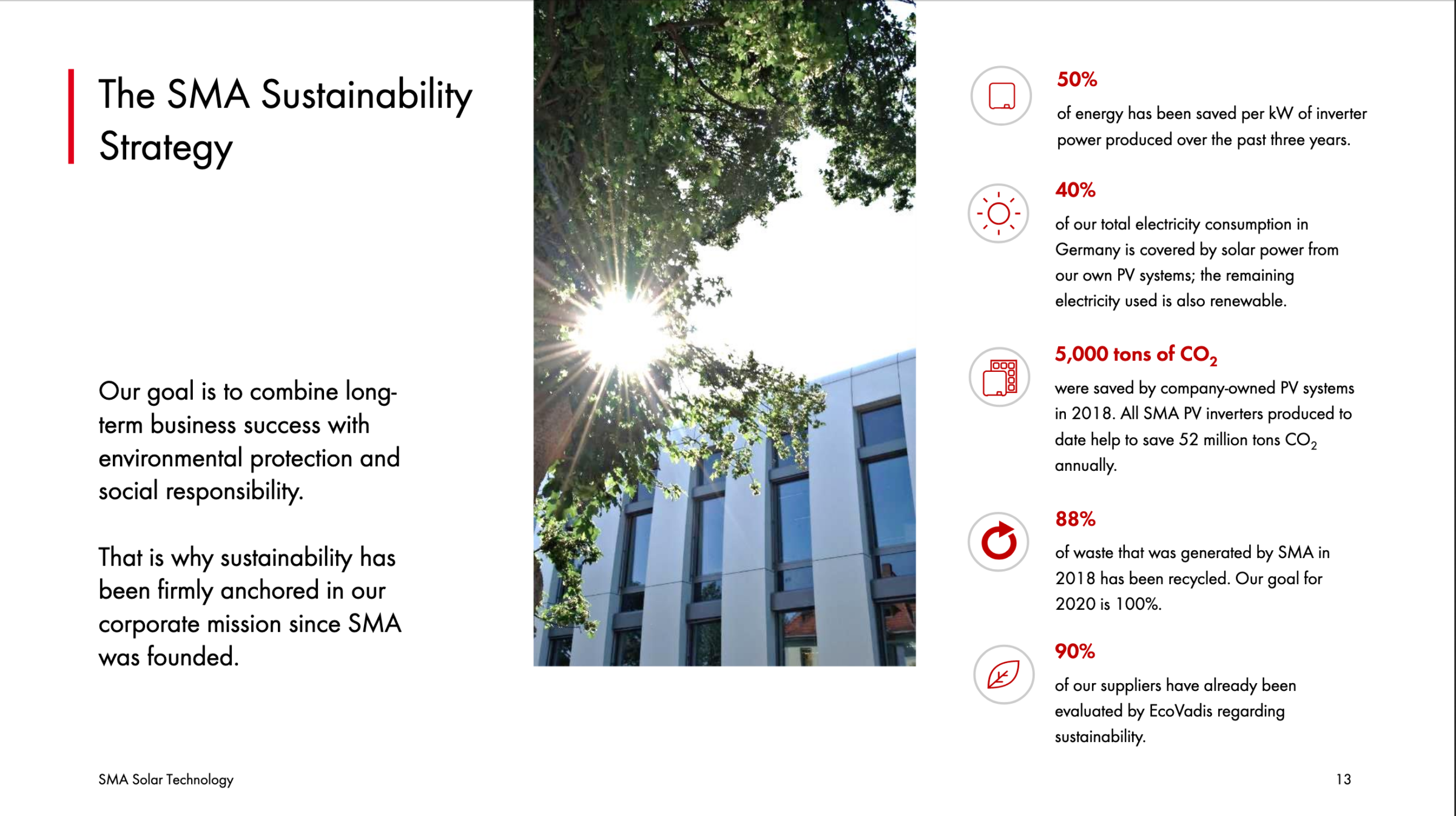On November 14, pv magazine held its first UP webinar, which focused on what companies can do to verify their sustainability credentials.
 Initiative partner and leading inverter manufacturer, SMA, joined the conversation, with senior communication & press manager Susanne Henkel, and global sustainability manager Matthias Schaepers discussing how integrating sustainability into business operations can reap economic advantages. They also identified what companies can do to quantify their green credentials and looked at why it’s so important to walk the talk.
Initiative partner and leading inverter manufacturer, SMA, joined the conversation, with senior communication & press manager Susanne Henkel, and global sustainability manager Matthias Schaepers discussing how integrating sustainability into business operations can reap economic advantages. They also identified what companies can do to quantify their green credentials and looked at why it’s so important to walk the talk.
There to kick off the discussion was Dustin Mulvaney, associate professor in the Department of Environmental Studies at San José State University in the U.S. He is an expert on sustainability in the solar industry, has published a very interesting book, Solar Power, Innovation, Sustainability and Environmental Justice at the start of this year, and has played an integral role in the creation of a new global sustainability standard for modules and inverters – a process that SMA has also been actively involved in – and which is set to be released soon.
During the webinar – the recording and presentations of which are now available online – Mulvaney explained why it is so crucial to be credible in the area of sustainability: “Green attributes are the primary attraction for photovoltaic industry investors, and questions about the greenness of the solar industry could limit market penetration. The green attributes attract most customers and draw public support for policies that foster solar power adoption.”
Overall, the discussion was a lively one, providing insight into what companies can do to quantify their sustainability credentials. While we managed to pose many questions throughout the webinar, there were many interesting ones we did not have time to address. Below you will find answers to those:
Dustin Mulvaney (presentation)
How much of an issue is greenwashing really in the solar and/or storage industries? Can you provide concrete examples of greenwashing by solar companies?
Greenwashing is probably not the best word choice. I do not suggest that manufacturers or developers are misleading consumers about the environmental benefits of photovoltaics, especially compared to alternatives. But there are differences in practices within the industry, and so long as there is a “green halo” placed on these technologies, we will not maximize the benefits they offer.
If you visit manufacturers’ websites, you can see the variation in the claims. Some companies see sustainability as “we make solar panels,” while others disclose a great deal about operations.
How can guidelines for sustainability reporting help in minimizing greenwashing?
Reporting activities, emissions, effluents, supply chains, and land use can draw attention to the variation in performance, and perhaps lead consumers to ask for modules from manufacturers that report. You can read about the sustainability standard we developed under NSF International here.
What's the best source for studies involving life cycle assessments (LCAs) for solar or renewables in general?
There are several very reputable scholars. Some last names include Raugei, Fthenakis, de Wild-Scholten, and Heath. Interpreting LCAs can be a bit misleading, because they are snapshots in time of typical operations, and do not capture all activities, accidents, etc. that are more representative of actual operations. Often comparing the results are like comparing apples and oranges, because of the variation in assumptions and data.
NREL did a harmonization of LCAs and the EIA developed guidelines for LCAs.
What is the CO2 footprint of a typical Si-based PV module versus that of a CIGS or CdTe module?
Cradle-to-gate footprints appear to favor CdTe to crystalline silicon, but modestly, and we don't have comprehensive information about the variation in crystalline operations and scale. CIGS is not at scale to make any results meaningful. Argonne Labs studied carbon footprints of PV modules made in China versus the EU and found them to be double in China. So geography of production likely matters more than technology.
Has the CO2 footprint of solar parks been analyzed?
I have not seen an adequate LCA that addresses land use change from solar farms and the variation in land use types in the way that biofuels LCAs include land use change.
Popular content
Matthias Schaepers, SMA (presentation)
In your presentation, you mentioned that 40% of the total electricity consumption in Germany is covered by solar power from your own PV systems, while the remaining electricity used is also renewable. Is the 60% procured via green certificates? I ask, because there has been criticism than green certificates essentially amount to greenwashing, because of their low costs – in Europe a certificate costs less than €0.01/kW – meaning they have little effect on new green energy capacity.
The 60% is carbon-neutral green energy provided by our local utility at the Kassel headquarters. 53% of the provided power is produced by renewable EEG-generation plants, the rest consists of power from other renewable sources. The part of regionally produced renewable power is more than 50%. Our supplier is constantly investing in regional renewable generation.
90% of your suppliers have been evaluated by EcoVadis. How did they respond to the requests to verify their sustainability credentials? When will the remaining 10% be evaluated? Have any suppliers declined to be evaluated? If yes, did SMA then refuse to work with them?
For big suppliers, it is usually no problem to provide comprehensive feedback to EcoVadis as they have implemented sustainability programs. For small suppliers, the high number of detailed questions can pose a challenge. In these cases, we try to we give smaller suppliers more time and opportunity to provide all answers and proof of their sustainability. However, as the EcoVadis evaluation is mandatory within our procurement process, we refuse to work with suppliers that don’t respond, The overall sustainability score of our suppliers that have been evaluated so far is 48, which is in the green area of the EcoVadis Scale. We have started the EcoVadis evaluation in 2018 and will conclude evaluation of all suppliers on an ongoing basis.
Do you think there is still a problem with convincing the decision makers to take sustainability in solar manufacturing seriously?
We have experienced different attitudes in the industry. With some of the players, sustainability in manufacturing is an important factor and decision makers are convinced of that. Others claim that producing equipment for sustainable energy supply is enough and therefore they don’t put a focus on sustainability in their own manufacturing and supply chain. Therefore, we think that initiatives like pv magazine’s UP initiative are extremely important in order to raise awareness within the whole industry, and we hope that our webinar has delivered valuable input in this context.
How much solar electricity needs to be generated to compensate for the CO2 emissions caused for production of an inverter?
That depends on the inverter category. Based on our lifecycle analysis we have calculated the energy payback time. Based on our insights, an inverter’s payback time (over the whole value chain) amounts to two months on average.
What currently cannot be recycled in an inverter? How is that waste dealt with?
The recycling capacities of an inverter very much depend on its design. In order to achieve a high recycling rate, the inverter must be designed in such a way that the individual recyclable materials can be separated and recycled after the service life of the inverter. We address this topic in particular with our guide to sustainable product design. One focus here is the topic of “design for recycling and disassembly”.
Are there plans to establish a worldwide recycling program for inverters? Is this necessary?
Currently, regulation varies a lot from country to country. It would be desirable to have a global regulation similar to the German “Kreislaufwirtschaftsgesetz”. On a company level, we are working on a global circular economy strategy, in order to maximize the use of secondary raw materials from used inverters. We think that this is part of our responsibility within the electronic industry.
Have you experienced any instances of greenwashing in the solar industry?
Yes. We have experienced examples in which companies don’t adhere to international standards when pointing out their sustainability, but rather just punctually report on parts of individual sustainability aspects or only focus on the positive impact of their products when these are used, but not on the company’s own environmental impact. We think that such a behavior is not good for the industry as a whole, as we as an industry have to act as a role model for other industries.
This content is protected by copyright and may not be reused. If you want to cooperate with us and would like to reuse some of our content, please contact: editors@pv-magazine.com.




By submitting this form you agree to pv magazine using your data for the purposes of publishing your comment.
Your personal data will only be disclosed or otherwise transmitted to third parties for the purposes of spam filtering or if this is necessary for technical maintenance of the website. Any other transfer to third parties will not take place unless this is justified on the basis of applicable data protection regulations or if pv magazine is legally obliged to do so.
You may revoke this consent at any time with effect for the future, in which case your personal data will be deleted immediately. Otherwise, your data will be deleted if pv magazine has processed your request or the purpose of data storage is fulfilled.
Further information on data privacy can be found in our Data Protection Policy.